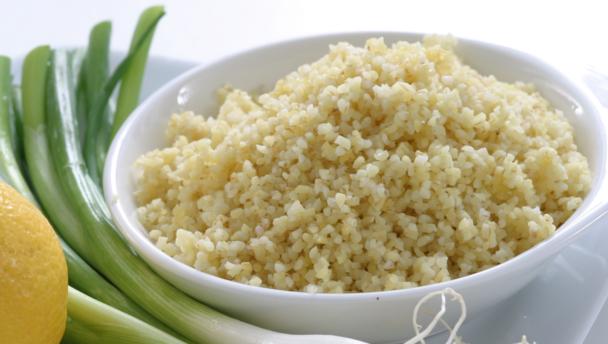

Pale-brown, pointy-shaped bulgur wheat is made by par-boiling, drying, then coarsely grinding wheat berries. Bulgur wheat is rich in protein and minerals, and has a nutty taste. Traditionally, the outer bran husks were removed by rubbing moistened wheat between one’s hands; the remaining grains were cracked. These days, the process is usually mechanised. Bulgur wheat is also known as bulgar or burghul wheat. In America, it is called cracked wheat, though that generally denotes a wholewheat variety.
 Chicken and lemon tagine with herby tabbouleh
Chicken and lemon tagine with herby tabbouleh
 Welsh lamb in hay with tabbouleh salad
Welsh lamb in hay with tabbouleh salad
 Harissa baked fish with bulgur wheat
Harissa baked fish with bulgur wheat
 Bulgur wheat salad with beetroot, honey and goats' cheese
Bulgur wheat salad with beetroot, honey and goats' cheese
 Smoked mackerel, radish, cucumber, dill and bulgur wheat grain bowl
Smoked mackerel, radish, cucumber, dill and bulgur wheat grain bowl
 Bulgur wheat balls
Bulgur wheat balls
 Tabbouleh
Tabbouleh
 Parsley, tomato and bulgar wheat salad
Parsley, tomato and bulgar wheat salad
Bulgur wheat is available in medium and coarse grades. Buy according to how you plan to use it.
Store in an airtight container in a cool, dry place.
Used in Middle Eastern, North African and Eastern European cookery, bulgur wheat is added to soups, rissoles, stuffed vegetables, and salads such as tabbouleh. The medium grade requires less soaking and cooking, so it's ideal for salads and Lebanese kibbeh. The coarse grade can be cooked for a long time without becoming soggy, so add it to casseroles, or steam or boil and serve as an accompaniment to spicy stews.
Article by Sejal Sukhadwala
Type the ingredients you want to use, then click Go. For better results you can use quotation marks around phrases (e.g. "chicken breast"). Alternatively you can search by chef, programme, cuisine, diet, or dish (e.g. Lasagne).